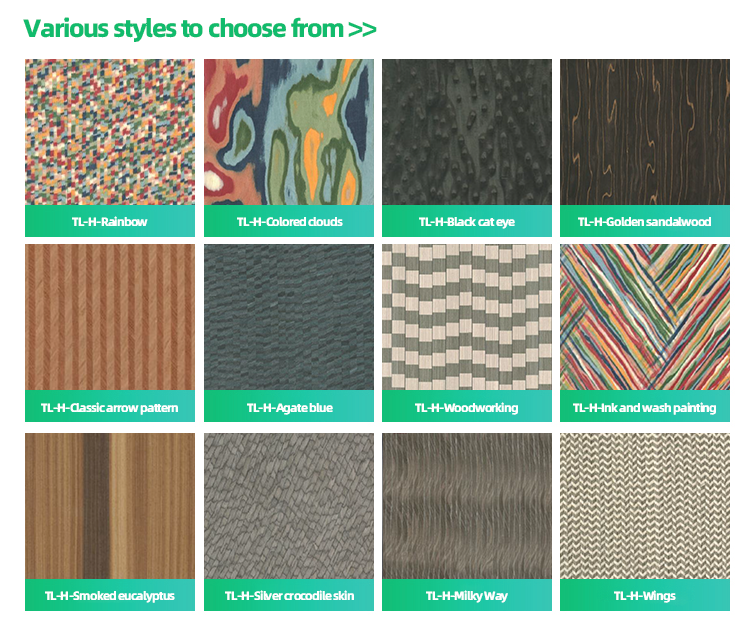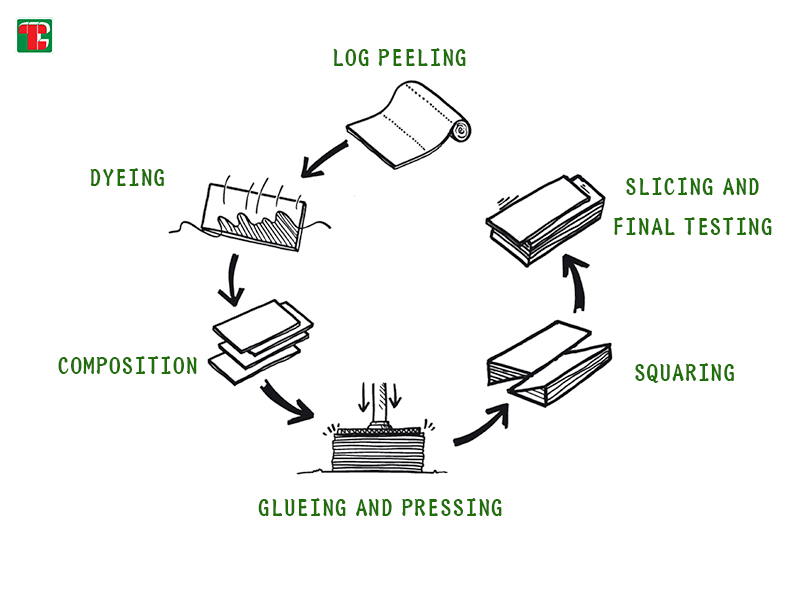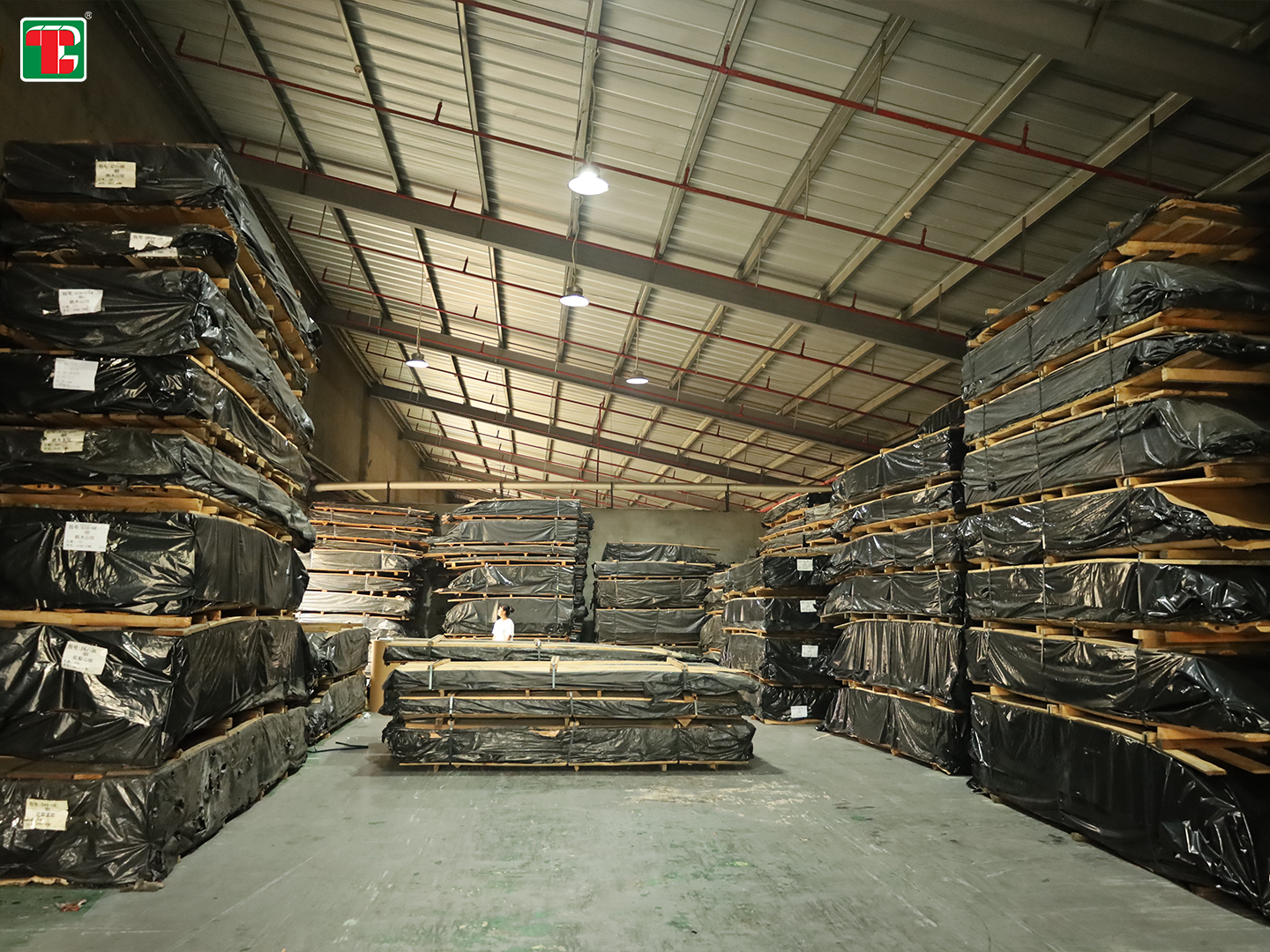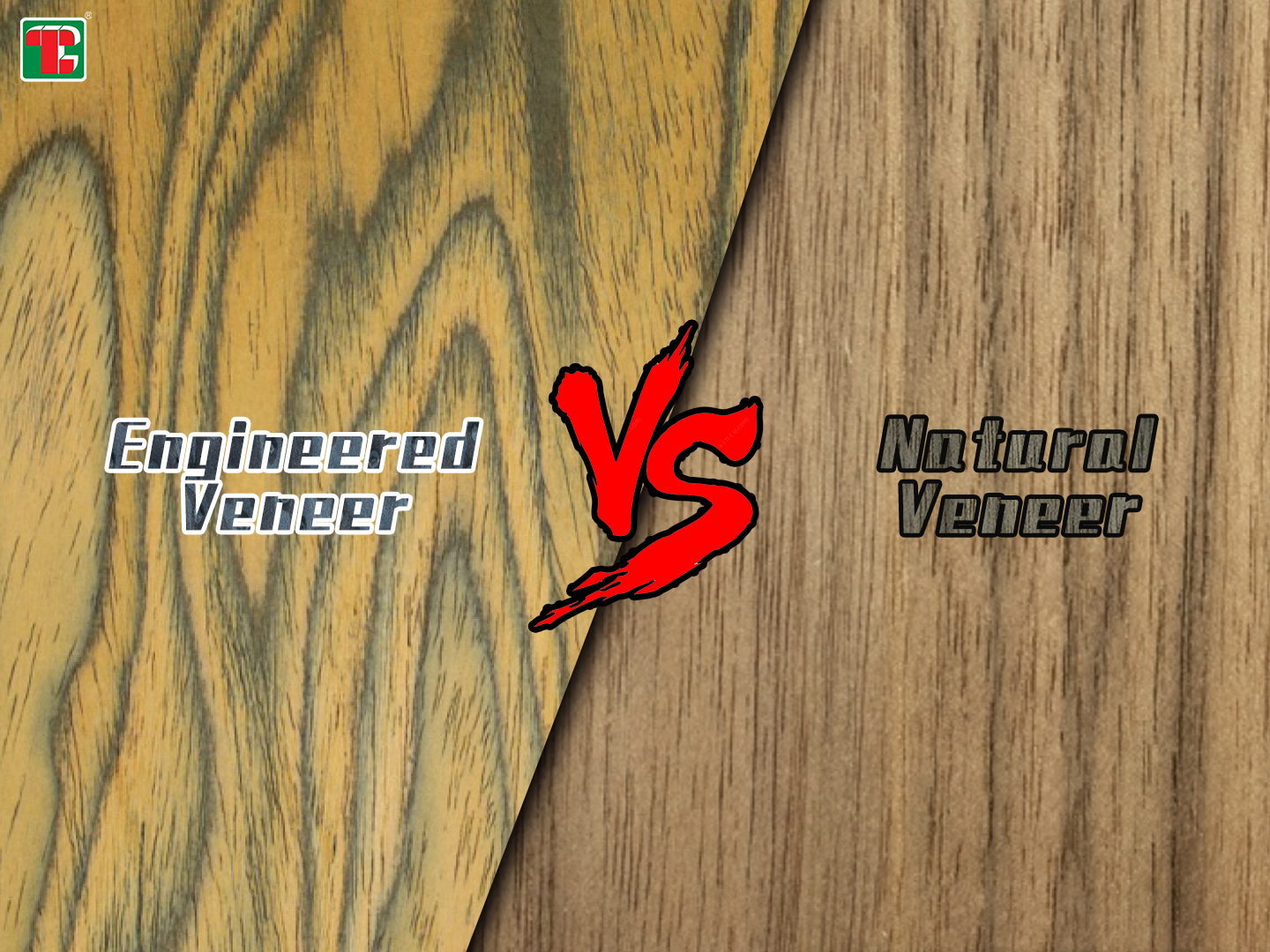Engineered wood veneers (EV), also referred to as reconstituted veneers (recon) or recomposed veneers (RV), are a type of re-manufactured wood product. Similar to natural veneer, engineered veneer originates from a natural wood core. However, the manufacturing process differs as engineered veneers are crafted using templates and pre-developed dye molds. This results in enhanced consistency in appearance and color, without the presence of surface knots and other natural variations commonly found in natural wood species. Despite these modifications, engineered veneers retain the natural wood grain from the core species used.
Utilizing wood that has undergone manufacturing processes, engineered wood veneers are often referred to by various names such as engineered, reconstituted, reconstructed, recomposed, man-made, manufactured, or composite wood. This process involves combining real wood strands, particles, or fibers with adhesives to create a composite wood material, maintaining the presence of real wood while incorporating other materials.
Veneers can be crafted from timber logs or reconstructed wood composites. When deciding between natural or reconstructed timber veneers for a project, the primary considerations typically revolve around aesthetics and cost.Natural wood veneers offer unique design outcomes due to the individual grain and figure of each log.
However, there may be significant color variations between natural veneer sheets, complicating the predictability of the final design outcome. In contrast, reconstructed wood veneers, such as ourTruewood range, provide consistency in color and grain, which may be preferred by designers for certain projects.
Reconstructed veneers become necessary when a rare wood species cannot be sourced for a natural veneer. Species like Ebony and Teak, included in our Truewood collection, are increasingly scarce and expensive as natural veneers, prompting the replication of their color and texture through reconstructed veneers.
Furthermore, considerations regarding sustainability, especially with the transition to certified timbers, can influence veneer production. Compliance with Australian logging laws and environmental consciousness may pose challenges in producing veneers from certain species.
Reconstructed wood veneers may be crafted from the same species as natural veneers or from cheaper species dyed to resemble others. They offer a suitable option for designers seeking uniform aesthetic outcomes.

Production Process:
The production process of engineered wood veneers involves several key steps to transform raw materials into finished veneer sheets. Here is an outline of the typical production process:
Raw Material Selection: The process begins with the selection of suitable raw materials. This may include rapidly growing and renewable tree species or reconstructed wood composites.
Slicing: The selected wood material is sliced into thin sheets using specialized equipment. These slices are usually very thin, typically between 0.2 to 0.4 millimeters in thickness.
Dyeing: The sliced wood veneers are dyed to achieve the desired color and appearance. Dyeing can be done using various methods and may involve the use of different dyes to create specific shades and patterns.
Drying: After dyeing, the veneer sheets are dried to remove excess moisture. Proper drying is essential to prevent warping or distortion of the veneer sheets.
Gluing: Once dried, the veneer sheets are glued together to form blocks of different shapes and sizes. The adhesive used in this process is carefully selected to ensure strong bonding and stability.
Shaping: The glued veneer blocks are then shaped according to the desired texture and pattern. This may involve cutting, sanding, or molding the blocks to achieve the desired appearance.
Slicing (again): After shaping, the veneer blocks are sliced once again into thinner sheets. These sheets will become the final engineered wood veneer products.
Quality Control: The sliced veneer sheets undergo rigorous quality control checks to ensure that they meet the required standards for appearance, color, and thickness.
Packaging: Finally, the high-quality veneer sheets are packaged and prepared for distribution to customers. Packaging may vary depending on customer requirements and the intended use of the veneer sheets.

Standard Sizes:
The standard sizes of engineered wood veneers typically adhere to industry norms to accommodate various applications. Here are the typical standard sizes:
Thickness: Engineered wood veneers usually have a thickness ranging between 0.2 to 0.4 millimeters. This thin profile allows for flexibility and ease of application.
Length: Standard lengths for engineered wood veneers commonly range from 2500 millimeters to a maximum of 3400 millimeters. These lengths provide versatility for different projects and installations.
Width: The standard width of engineered wood veneers is typically around 640 millimeters, with a maximum width of 1250 millimeters. These dimensions offer sufficient coverage for most surface areas while allowing for efficient handling during installation.
Additionally, many manufacturers offer customized sizes to meet specific project requirements. This OEM (Original Equipment Manufacturer) service allows customers to order veneer sheets tailored to their exact length, width, and thickness specifications.
Furthermore, engineered wood veneers may come with different backing options, such as original backing, fleece (non-woven fabric) backing, or kraft paper backing. These backing materials provide additional support and stability to the veneer sheets during installation and usage.

Special Features:
The features of engineered wood veneers distinguish them as versatile and practical alternatives to natural wood veneers. Here are the key features:
Consistency in Appearance and Color: Engineered wood veneers offer a uniform appearance and color due to their manufacturing process, which involves templates and pre-developed dye molds. This consistency ensures that each veneer sheet matches the desired aesthetic of the project.
Elimination of Natural Imperfections: Unlike natural wood veneers, engineered veneers are free from surface knots, cracks, and other natural characteristics found in wood species. This absence of imperfections enhances the overall visual appeal of the veneer sheets.
Smooth Surface Texture: Engineered wood veneers boast a smooth surface texture, enhancing their tactile quality and making them suitable for a variety of applications, including furniture making, interior design, and architectural projects.
High Color Consistency: The manufacturing process of engineered wood veneers results in high color consistency across multiple sheets. This uniformity simplifies the design process and ensures cohesive aesthetics in large-scale projects.
High Wood Utilization Rate: Engineered veneers maximize wood utilization by using strands, particles, or fibers mixed with adhesives to create composite wood materials. This eco-friendly approach reduces waste and promotes sustainability in wood production.
Ease of Processing: Engineered wood veneers are easy to work with, allowing for effortless cutting, shaping, and installation. This ease of processing makes them ideal for both professional craftsmen and DIY enthusiasts.
Reproducibility: The manufacturing process of engineered veneers ensures reproducibility, meaning that identical veneer sheets can be produced consistently over time. This feature is beneficial for large-scale projects requiring uniformity in design.
Cost-Effectiveness: Engineered wood veneers are often more affordable than natural wood veneers, making them a cost-effective option for budget-conscious projects without compromising on quality or aesthetics.


Factors Affecting Price:
Several factors influence the pricing of engineered wood veneers, reflecting their quality, production process, and market demand. Here are the main factors affecting the price:
Raw Materials: The type and quality of raw materials used in manufacturing significantly impact the price of engineered wood veneers. Popular and readily available wood species tend to be less expensive, while rare or exotic species command higher prices. Additionally, the quality of the wood, such as its grain pattern and color, can influence pricing.
Glue Quality: The quality of adhesive used in bonding the wood particles or fibers together affects the durability and performance of engineered wood veneers. Environmentally friendly adhesives, such as E1 grade, are typically more expensive than standard adhesives like E2 grade. Higher-quality glue contributes to a higher price for the final product.
Dye Quality: The quality of dyes and pigments used to color the veneers plays a crucial role in their final appearance and longevity. Higher-grade dyes offer better colorfastness and resistance to fading over time, resulting in higher-priced veneers. Cheaper dye materials may lead to color changes or inconsistencies, impacting the overall quality of the veneers.
Manufacturing Process: The complexity and efficiency of the manufacturing process influence production costs, which in turn affect the pricing of engineered wood veneers. Advanced techniques and equipment may result in higher-quality veneers but also increase production expenses, leading to higher prices for the end product.
Market Demand: Supply and demand dynamics in the market affect the pricing of engineered wood veneers. High demand for specific wood species or designs may drive up prices, especially for rare or trendy options. Conversely, lower demand or oversupply can lead to price reductions to stimulate sales.
Brand Reputation: Established brands with a reputation for high-quality products may command higher prices for their engineered wood veneers. Customers are often willing to pay a premium for veneers from reputable brands known for their durability, consistency, and customer service.
Customization Options: Customization services, such as tailored sizes, special finishes, or unique designs, may incur additional costs, contributing to higher prices for engineered wood veneers. Customers willing to pay for personalized features or bespoke solutions can expect to pay more for their veneers.

Comparisons Between Engineered And Natural Wood Veneers
Comparing engineered wood veneers (EV) and natural wood veneers provides insights into their respective characteristics, benefits, and suitability for different applications. Here's a comparison between the two:
Composition:
Engineered Wood Veneers: EVs are manufactured from real wood materials that undergo processing, such as slicing, dyeing, and gluing, to create composite veneer sheets. They may include strands, particles, or fibers mixed with adhesives.
Natural Wood Veneers: Natural veneers are sliced directly from logs of various wood species, retaining the unique grain patterns, textures, and colors of the original wood.
Appearance and Consistency:
Engineered Wood Veneers: EVs offer consistent appearance and color across multiple sheets due to the controlled manufacturing process. They are free from natural imperfections like knots and blemishes, providing a uniform aesthetic.
Natural Wood Veneers: Natural veneers showcase the inherent beauty and variability of wood, with each sheet possessing unique grain patterns, textures, and colors. However, this natural variation may result in inconsistency between sheets.
Durability and Stability:
Engineered Wood Veneers: EVs are engineered to be stable and durable, with enhanced resistance to warping, splitting, and moisture damage compared to natural wood. The manufacturing process allows for precise control over thickness and quality.
Natural Wood Veneers: Natural veneers may be susceptible to warping, cracking, and color fading over time, especially in high-moisture environments. However, properly finished and maintained natural veneers can exhibit excellent durability.
Versatility and Customization:
Engineered Wood Veneers: EVs offer versatility in terms of size, color, and texture, with customization options available to meet specific project requirements. They can mimic a wide range of wood species and patterns.
Natural Wood Veneers: Natural veneers provide a unique and authentic aesthetic that cannot be precisely replicated. While customization options exist, they may be limited by the natural characteristics of the wood species.
Cost:
Engineered Wood Veneers: EVs are often more cost-effective than natural veneers, making them an attractive option for budget-conscious projects. The controlled manufacturing process and use of renewable resources contribute to their affordability.
Natural Wood Veneers: Natural veneers tend to be more expensive due to the labor-intensive process of harvesting, slicing, and finishing the wood. Rare or exotic wood species may command premium prices.
Sustainability:
Engineered Wood Veneers: EVs promote sustainability by maximizing wood utilization and reducing waste. They often utilize fast-growing and renewable wood species, minimizing environmental impact.
Natural Wood Veneers: Natural veneers rely on the extraction of finite natural resources and may contribute to deforestation if not sourced responsibly. However, sustainably harvested and certified natural veneers are available to mitigate environmental concerns.

Post time: May-23-2024







